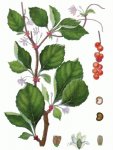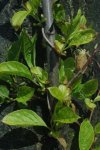Schizandra chinese
Schizandra chinensis (Turcz.) Baill.
Botanical characteristics. The family is magnoliaceous. Perennial winding liana 10-15 m high with a branching thick stalk and brown smooth bark. Has a powerful rhizome with roots that depart from it. Leaves alternate, petiolate, obovate, fleshy. White-pink flowers, beautiful and fragrant, are collected on several pieces on long pedicels. Blossoms in May-June. Fruits - globular red berries, ripen in August-September.
Spread. It grows in the Far East, Sakhalin and the Kuril Islands on the fringes of mixed forests, along the banks of water bodies. Grown for medical purposes. As an ornamental plant is found in parks, gardens of the European territory of our country.
Used parts of the plant.
Fruits, stems, roots.
Seeds of the plant contain fatty (26.9%) and essential (1.6%) oils, schisandrine (0.12%), schizandrol and glycerides of linolenic and oleic acids. The biological activity of Schizandra, apparently, is due to Schisandrine and Schizandrol.
Application.
Schizandra stimulates cardiac activity and breathing, tones up the central nervous system, is a good stimulant for mental and physical fatigue, as well as impotence. Schizandra preparations increase the sensitivity of peripheral and central vision.
Schisandra helps with any acute and chronic diseases, accompanied by asthenic conditions: in diseases of the respiratory tract, with diseases of the stomach and intestines, kidneys, liver, blood diseases, etc.
Preparation.
The dose is selected individually. Residents of the Far East chew berries of magnolia vine, as well as brew them as tea.
Pharmaceutical preparations: tincture of magnolia vine (10-30 drops 2-3 times a day with water before meals), powders of magnolia vine (0.5 g 2 times a day), tablets of magnolia vine (1 tablet 1-2 Times a day).




Comments
When commenting on, remember that the content and tone of your message can hurt the feelings of real people, show respect and tolerance to your interlocutors even if you do not share their opinion, your behavior in the conditions of freedom of expression and anonymity provided by the Internet, changes Not only virtual, but also the real world. All comments are hidden from the index, spam is controlled.